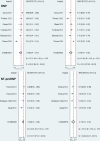Cardiac natriuretic peptides for diagnosis of covert atrial fibrillation after acute ischaemic stroke: a meta-analysis of diagnostic accuracy studies
- PMID: 33004611
- PMCID: PMC8005900
- DOI: 10.1136/svn-2020-000440
Cardiac natriuretic peptides for diagnosis of covert atrial fibrillation after acute ischaemic stroke: a meta-analysis of diagnostic accuracy studies
Abstract
Background and purpose: Detection of atrial fibrillation (AF) after acute ischaemic stroke is pivotal for the timely initiation of anticoagulation to prevent recurrence. Besides heart rhythm monitoring, various blood biomarkers have been suggested as complimentary diagnostic tools for AF. We aimed to summarise data on the performance of cardiac natriuretic peptides for the diagnosis of covert AF after acute ischaemic stroke and to assess their potential clinical utility.
Methods: We searched PubMed and Embase for prospective studies reporting the performance of B-type natriuretic peptide (BNP) or N-terminal pro-BNP (NT-proBNP) for the diagnosis of covert AF after acute ischaemic stroke. Summary diagnostic performance measures were pooled using bivariate meta-analysis with a random-effect model.
Results: We included six studies focusing on BNP (n=1930) and three studies focusing on NT-proBNP (n=623). BNP had a sensitivity of 0.83 (95% CI 0.64 to 0.93), a specificity of 0.74 (0.67 to 0.81), a positive likelihood ratio of 3.2 (2.6 to 4.0) and a negative likelihood ratio of 0.23 (0.11 to 0.49). NT-proBNP had a sensitivity of 0.91 (0.65 to 0.98), a specificity of 0.77 (0.52 to 0.91), a positive likelihood ratio of 3.9 (1.8 to 8.7) and a negative likelihood ratio of 0.12 (0.03 to 0.48). Considering a pretest probability of 20%, BNP and NT-proBNP had post-test probabilities of 45% and 50%.
Conclusions: NT-proBNP has a better performance than BNP for the diagnosis of covert AF after acute ischaemic stroke. Both biomarkers have low post-test probabilities and may not be used as a stand-alone decision-making tool for the diagnosis of covert AF in patients with acute ischaemic stroke. However, they may be useful for a screening strategy aiming to select patients for long-term monitoring of the heart rhythm.
Keywords: embolic; statistics; stroke.
© Author(s) (or their employer(s)) 2021. Re-use permitted under CC BY-NC. No commercial re-use. See rights and permissions. Published by BMJ.
Conflict of interest statement
Competing interests: GCJ receives research support from Canadian Institutes of Health Research, the National Institutes of Health, The Heart and Stroke Foundation, the Canada Foundation for Innovation and the Alberta University Hospital Foundation.
Figures


Similar articles
-
B-type natriuretic peptide over N-terminal pro-brain natriuretic peptide to predict incident atrial fibrillation after cryptogenic stroke.Eur J Neurol. 2021 Feb;28(2):540-547. doi: 10.1111/ene.14579. Epub 2020 Nov 13. Eur J Neurol. 2021. PMID: 33043545
-
Natriuretic peptides for the detection of paroxysmal atrial fibrillation in patients with cerebral ischemia--the Find-AF study.PLoS One. 2012;7(4):e34351. doi: 10.1371/journal.pone.0034351. Epub 2012 Apr 11. PLoS One. 2012. PMID: 22509292 Free PMC article.
-
Preoperative B-Type Natriuretic Peptides to Predict Postoperative Atrial Fibrillation in Cardiac Surgery: A Systematic Review and Meta-Analysis.Heart Lung Circ. 2024 Jan;33(1):23-32. doi: 10.1016/j.hlc.2023.10.015. Epub 2023 Dec 23. Heart Lung Circ. 2024. PMID: 38143193
-
Biomarkers for the detection of covert atrial fibrillation after ischemic stroke: NT-proBNP or BNP?J Stroke Cerebrovasc Dis. 2025 Jun;34(6):108239. doi: 10.1016/j.jstrokecerebrovasdis.2025.108239. Epub 2025 Feb 1. J Stroke Cerebrovasc Dis. 2025. PMID: 39900314
-
Detection of cardioembolic stroke with B-type natriuretic peptide or N-terminal pro-BNP: a comparative diagnostic meta-analysis.Int J Neurosci. 2018 Nov;128(11):1100-1108. doi: 10.1080/00207454.2017.1408612. Epub 2018 Jun 6. Int J Neurosci. 2018. PMID: 29874952
Cited by
-
N-Terminal Pro-brain Natriuretic Peptide Is Associated With Hemorrhagic Transformation and Poor Outcomes in Patients With Stroke Treated With Intravenous Thrombolysis.Front Mol Neurosci. 2021 Nov 22;14:758915. doi: 10.3389/fnmol.2021.758915. eCollection 2021. Front Mol Neurosci. 2021. PMID: 34880725 Free PMC article.
-
Cardiac biomarkers are associated with increased risks of adverse clinical outcomes after ischemic stroke.J Neurol. 2024 Sep;271(9):6313-6324. doi: 10.1007/s00415-024-12536-5. Epub 2024 Aug 6. J Neurol. 2024. PMID: 39105893
-
The relationship between atrial cardiopathy biomarkers and prognosis of patients with acute ischemic stroke after endovascular treatment.Neurotherapeutics. 2024 Mar;21(2):e00327. doi: 10.1016/j.neurot.2024.e00327. Epub 2024 Feb 5. Neurotherapeutics. 2024. PMID: 38320384 Free PMC article.
-
ESC Working Group on e-Cardiology Position Paper: accuracy and reliability of electrocardiogram monitoring in the detection of atrial fibrillation in cryptogenic stroke patients : In collaboration with the Council on Stroke, the European Heart Rhythm Association, and the Digital Health Committee.Eur Heart J Digit Health. 2022 Jun 8;3(3):341-358. doi: 10.1093/ehjdh/ztac026. eCollection 2022 Sep. Eur Heart J Digit Health. 2022. PMID: 36712155 Free PMC article. Review.
-
Diagnostic Utility of N-Terminal Pro-B-Type Natriuretic Peptide in Identifying Atrial Fibrillation Post-Cryptogenic Stroke: A Systematic Review and Meta-Analysis.Pathophysiology. 2024 Jun 30;31(3):331-349. doi: 10.3390/pathophysiology31030024. Pathophysiology. 2024. PMID: 39051222 Free PMC article.
References
Publication types
MeSH terms
Substances
LinkOut - more resources
Full Text Sources
Medical
Research Materials
